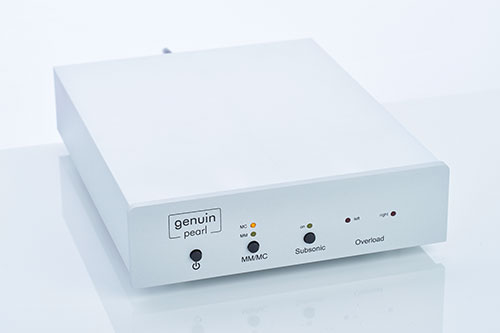It wouldn’t be very much surprising if you, albeit being a proven aficionado of analogue playback techniques, haven’t yet come across a company named Blue Amp – although they have been offering very well-reputed phono preamps for about 20 years now. On the one hand, this fine piece of electronics is a rare product of luxury, on the other hand, Blue Amp does without any kind of marketing.
Blue Amp mirrors Rolf Becker’s passion for music and its ways of analogue playback. As a certified radio and TV technician, besides being an engineer for bio-medical technology as well, he, of course, designs his phono amps all by himself, and he doesn’t outsource the manufacturing for reasons of quality either. The enclosures obviously are purchased from third parties, but Rolf Becker equips and solders the circuit boards himself by hand. Such a close proximity to one’s own product is extremely rare to find in times normally tied to high volumes and sales figures, especially because the highly professional manufacturing of the Blue Amps is effected in addition to a demanding full-time job in a different field, and thus practically files under leasure enjoyment. Anyone who has ever spoken to Rolf Becker about his products or even about analogue music reproduction is going to be – like me – firmly convinced, that engaging himself in these matters really is a matter of heart to him. However, notwithstanding the fun side of things there are a few issues that Rolf Becker is not even willing to discuss: his phono preamps are exclusively designed to work with moving-coil cartridges and feature balanced inputs only. This philosophy already applies to the Model Blue MK II, the entry-level model priced at 2.400 euros. The Model Surzur, which on the website is recommended as the intermediate model, builds the bridge to Blue Amp’s best-choice model which has been available since the beginning of the year in the MKIII version, also equipped with balanced connections on the output section.

Let us briefly recall the symmetry aspect: When we first met, Rolf Becker not only brought along a 42 – at time an MK II version – but also a single moving coil cartridge and a complete Thorens turntable escorted by lots of long cables, which he used to vividly and convincingly demonstrate to me the advantages of a balanced signal processing. And with his little, educationally valuable spectacle, he really would have made me convinced of the immense advantages of the balanced amplification of sensitive signals - if I hadn’t been it for decades! Hum problems, radio interferences in the audio system and short clicks when operating power switches of, for example, lamps near the turntable are things of the past within my audio system, since I chose the balanced version of Einstein's The Turntable's Choice to take over the amplification. Moreover, an MC cartridge is one of the few genuine balanced source components. However, in contrast to an un-balanced circuitry, a balanced one requires double the number of components and a considerably higher grade of selection – for only when both circuit branches are largely identical, an effective common-mode rejection and thus electrical noise suppression can be achieved. Opposed to this, of course, there are the aforementioned sonic advantages. To be honest, Rolf Becker’s commitment to balanced signal processing charged an open door with me.

His proposal, to delay the test of the 42 until one of the first models of the updated MK III series would be available, I also immediately agreed to. In the autumn of last year, I spent a few days in Alsace and at the neighbouring Kaiserstuhl, and took the opportunity for a stop-over at Rolf Becker: the small workshop turned out to be a real manufactory. The production of larger series would not be possible here, but that is not intended either. However, what is really remarkable is his fleet of measuring instruments. Rolf Becker is one of the designers who both listen and measure: the workshop and the listening room are only separated by a door. And after listening to only one or two songs, it becomes clear that the lover of panel speakers, despite putting a different emphasis on particular hifi criteria than me, made his audio chain deliver a very transparent sound, capable of meticulously showing even very small changes in the system. In addition, I could also give a brief listen to the prototype of an interesting new development, of which I am only allowed to say that it doesn’t belong to the world of phono pre-amplifiers.




























 |
|























































































